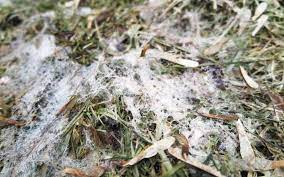A lawn is a point of pride for many homeowners. A well maintained lawn can be a beautiful thing, and it signifies to people who see it that the people who own the home have their lives together and generally have it going on. However, there are signs that all is not well on a homeowner's lawn. One of the worst signs is that of snow mold.
What is Snow Mold?

Snow mold is a type of fungus and disease that affects grass. It is most typically a remnant of winter weather. It appears in the form of large, mostly gray/whitish patches of grass that are noticeably discolored compared to the healthier grass around it. If left unchecked it can kill the grass in your yard.
What Causes Snow Mold?
As its name implies, snow mold often occurs after heavy snowfall. The spores that cause snow mold actually live in your lawn's soil all year long. However, it is when the temperature reaches between 32 and 45 degrees Fahrenheit that the moisture from snow soaks into the soil. This moisture causes the mold spores to sprout and spread to the grass in your lawn.
It needs to be understood that snow mold does not merely affect your lawn. Snow mold can affect the health of anybody who walks on your lawn or lives in your home. This is because the spores that snow mold emits can trigger allergic reactions and allergy-like symptoms in people. Frequent exposure can lead to serious illness if the snow mold is not dealt with. Any type of mold is not to be taken lightly. Mold is so powerful that it's been developed and used as a bio-weapon in the past.
There are Two Types of Snow Mold
Gray
Typhula blight
Of the two molds, this is the less serious to deal with. Gray snow mold typically only affects the blades of the grass. This means that so long as the blades are removed, there is a good chance that the grass can regrow normally, without any snow mold attached.
Pink
Microdochium patch
This is the more serious of the two molds as it does not merely go after the blades of grass, but the entire root system as well.
How to Treat Snow Mold in Your Yard
The good news about snow mold is that it is relatively easy to find in your yard. The bad news, however, is that there is no treating it. Once a patch of your yard is affected with snow mold, it cannot be salvaged or restored.
If you are dealing with Gray snow mold then you can cut the affected area and maintain some hope that the grass will grow back normal (provided that the affected blades of grass are completely removed from the area). If you are dealing with pink mold then the situation is a little more dire as the mold will go all the way into the grass's roots. The best thing to do is let the weather warm up, clear away all of the affected grass.
How to Prevent Snow Mold
If you want to prevent snow mold then you will be happy to know that there are several preventative steps that you can take.
Mow Your Yard
If you cut your grass down short enough before the first snow then you can lower the odds of snow mold growing.
Apply Preventative Fungicide
Before snow mold makes its way to your home, you can apply a preventative fungicide. This will kill the mold before it has a chance to take hold of your yard.
Prevent Pools of water
Mold loves to grow in areas that have plenty of moisture. While there will always be a degree of moisture on your lawn, preventing pools of water from forming will ultimately decrease the possibility of mold growth. The best way to do this is to be sure that your yard has proper drainage in which any pooled water can be swiftly taken care of.
No Leaf Piles
Do not allow for piles of leaves to remain in your yard for long periods of time as they have a tendency to become mold magnets. They are veritable breeding grounds for mold and can only exacerbate the problem.

